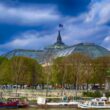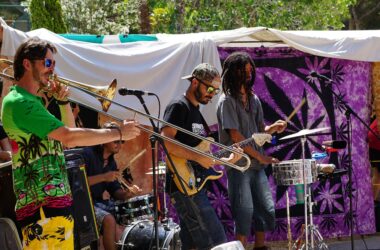The Alexandre III Bridge, spanning the Seine River in Paris, is more than just a crossing. It’s a symbol of the Franco-Russian alliance, a marvel of engineering, and an iconic piece of Parisian architecture. This ornate bridge, adorned with Art Nouveau lamps, cherubs, nymphs, and winged horses, connects the Champs-Élysées quarter with the Invalides and Eiffel Tower districts. Its significance extends beyond its practical use, representing the grandeur and elegance of Belle Époque Paris.
Table of Contents
- Historical Background
- Architectural Design
- Engineering Marvel
- Cultural and Artistic Significance
- Tourist Attraction
- Restoration and Preservation
- Photographic Opportunities
- Seasonal Variations
- Alexandre III Bridge at Night
- Personal Experiences
- Comparisons with Other Bridges
- Alexandre III Bridge in Media
- Planning Your Visit
- Conclusion
- FAQs
Historical Background
Constructed for the 1900 Exposition Universelle (World’s Fair), the bridge was designed to celebrate the Franco-Russian alliance. It was named after Tsar Alexandre III, the Russian ruler who concluded the Franco-Russian Alliance in 1892. The bridge’s foundation stone was laid by his son, Tsar Nicholas II, in October 1896. The collaboration involved several prominent figures, including architects Joseph Cassien-Bernard and Gaston Cousin, as well as engineers Jean Résal and Amédée Alby.
Architectural Design
Architectural Style and Features
The Alexandre III Bridge is a stunning example of Beaux-Arts architecture. It features elaborate decorations, with sculptures by some of the most celebrated artists of the time, including Jules Dalou, Georges Récipon, and Henri Gauquié. The bridge’s single span steel arch, which allows for unobstructed views, is a testament to the advanced engineering techniques of the period.
Materials Used
The bridge is constructed primarily of steel, which provides the necessary strength to support its wide arch. The ornate elements, including the sculptures and lamp posts, are made from gilded bronze and stone, adding to the bridge’s majestic appearance.
Notable Sculptures and Ornamentations
One of the bridge’s most striking features is its four pylons, each crowned with a gilt-bronze statue representing the arts, sciences, commerce, and industry. Additionally, there are numerous cherubs, nymphs, and winged horses that embellish the bridge, making it a true work of art.
Engineering Marvel
Structural Design and Techniques
The Alexandre III Bridge was a pioneering project in terms of engineering. Its single-span steel arch was designed to ensure that no piers obstructed the views along the Seine. This required precise calculations and innovative construction techniques, especially for its time.
Challenges During Construction
One of the main challenges was constructing a bridge that was both structurally sound and aesthetically pleasing. The engineers had to ensure that the bridge could support the weight of the heavy sculptures without compromising its stability. Additionally, they had to work within the constraints of the existing urban environment.
Innovations Introduced
The use of steel in such a large and decorative structure was innovative for the time. This material choice allowed for the creation of a span that was not only strong but also lightweight and elegant.
Cultural and Artistic Significance
Influence on Art and Literature
The bridge has been a source of inspiration for many artists and writers. Its beauty and grandeur have been depicted in countless paintings, photographs, and literary works, cementing its place in French culture.
Role in French Culture
The Alexandre III Bridge is more than a functional piece of infrastructure; it is a cultural icon. It serves as a backdrop for numerous events and celebrations, including Bastille Day parades and New Year’s Eve festivities.
Popular Culture References
The bridge has appeared in several films, TV shows, and music videos, further enhancing its status as a cultural landmark. Its picturesque setting makes it a favorite location for filmmakers and photographers alike.
Tourist Attraction
Key Attractions on the Bridge
Tourists flock to the Alexandre III Bridge to admire its ornate decorations and take in the panoramic views of Paris. Key attractions include the gilded sculptures, the Art Nouveau lamps, and the breathtaking vistas of the Seine River.
Activities and Events
Throughout the year, the bridge hosts various events, from art exhibitions to street performances. It’s also a popular spot for wedding photos and romantic walks.
Nearby Landmarks and Attractions
Located in the heart of Paris, the bridge is within walking distance of several major attractions, including the Grand Palais, the Petit Palais, and the Eiffel Tower. This makes it an ideal starting point for a day of sightseeing.
Restoration and Preservation
Restoration Efforts Over the Years
Given its age and the exposure to the elements, the bridge has undergone several restoration projects. These efforts have focused on preserving its structural integrity and restoring its ornate decorations to their former glory.
Preservation Techniques
Restoration teams use a combination of traditional techniques and modern technology to maintain the bridge. This includes cleaning and repairing the gilded sculptures, reinforcing the steel structure, and applying protective coatings to prevent corrosion.
Challenges in Maintenance
Maintaining such a historic structure is not without its challenges. The bridge’s intricate details require careful attention, and the constant exposure to traffic and weather means that ongoing maintenance is essential.
Photographic Opportunities
Best Spots for Photography
The Alexandre III Bridge offers numerous photographic opportunities. Some of the best spots include the western end, where you can capture the Eiffel Tower in the background, and the central span, which offers unobstructed views of the Seine.
Tips for Capturing the Best Shots
For the best photos, visit the bridge during the golden hours of sunrise and sunset. The soft lighting during these times enhances the bridge’s details and provides a warm, inviting glow.
Iconic Views and Vistas
From the bridge, you can enjoy iconic views of several Parisian landmarks, including the Eiffel Tower, the Grand Palais, and the Musée d’Orsay. These vistas make for stunning photographs that capture the essence of Paris.
Seasonal Variations
Bridge in Different Seasons
The Alexandre III Bridge is beautiful year-round, but it offers different experiences depending on the season. In spring, the surrounding trees are in full bloom, while autumn brings a palette of warm colors. Winter often adds a magical touch with a light dusting of snow.
Seasonal Events and Festivals
Each season brings its own set of events and festivals to the bridge. In summer, it’s a popular spot for open-air concerts, while winter sees festive light displays and holiday markets.
Impact of Weather on the Bridge
Weather can affect the bridge’s appearance and accessibility. Rain can make the surfaces slippery, while snow adds a picturesque element but may require careful navigation.
Alexandre III Bridge at Night
Illumination and Nighttime Beauty
At night, the bridge is illuminated by a series of Art Nouveau lamps, creating a magical ambiance. The lights highlight the bridge’s ornate details and cast a beautiful reflection on the Seine.
Nighttime Events
The bridge is a popular location for nighttime events, including fireworks displays and evening cruises. It’s also a favorite spot for romantic walks and nighttime photography.
Safety Tips for Night Visits
While the bridge is generally safe to visit at night, it’s always a good idea to stay aware of your surroundings. Stick to well-lit areas and consider visiting with a group for added security.
Personal Experiences
Anecdotes from Visitors
Many visitors have shared memorable experiences from their visits to the Alexandre III Bridge. Some recall romantic proposals, while others remember the stunning views during a leisurely stroll.
Personal Insights and Recommendations
If you’re planning a visit, take your time to explore the bridge’s details. Look closely at the sculptures and enjoy the views from different angles. Visiting early in the morning or late in the evening can provide a more peaceful experience.
Unforgettable Moments
Whether it’s watching the sunset over the Seine or capturing a perfect photograph of the Eiffel Tower, the bridge offers countless unforgettable moments.
Comparisons with Other Bridges
Comparison with Other Famous Bridges in Paris
Paris is home to several iconic bridges, each with its own unique charm. Compared to the simplicity of Pont Neuf or the modernity of Pont de l’Alma, the Alexandre III Bridge stands out for its opulence and grandeur.
Unique Aspects of Alexandre III Bridge
What sets the Alexandre III Bridge apart is its combination of engineering prowess and artistic beauty. Its elaborate decorations and strategic location make it a standout among Parisian bridges.
Global Comparisons
On a global scale, the bridge is often compared to other historic and ornate bridges, such as London’s Tower Bridge and San Francisco’s Golden Gate Bridge. However, its unique blend of French artistry and engineering makes it truly one-of-a-kind.
Alexandre III Bridge in Media
Appearances in Films and TV Shows
The bridge has been featured in numerous films and TV shows, often serving as a symbol of Parisian elegance and romance. Notable appearances include “Midnight in Paris” and “James Bond: A View to a Kill.”
References in Literature
Literary works have also immortalized the bridge, using it as a setting for dramatic scenes and romantic encounters. Its presence in literature adds to its mystique and allure.
Social Media Presence
In the age of social media, the bridge has become a popular subject for Instagram posts and travel blogs. Its picturesque views and intricate details make it a favorite among photographers and influencers.
Planning Your Visit
Best Times to Visit
For the best experience, visit the bridge early in the morning or late in the evening. These times offer fewer crowds and better lighting for photography.
How to Get There
The bridge is easily accessible by public transport. The nearest metro stations are Invalides and Champs-Élysées – Clemenceau. You can also reach the bridge by bus or on foot from nearby attractions.
Tips for a Memorable Visit
To make the most of your visit, wear comfortable shoes, bring a camera, and take your time to explore both ends of the bridge. Don’t forget to check out the nearby landmarks and attractions.
Conclusion
The Alexandre III Bridge is not just a bridge; it’s a masterpiece of art and engineering, a symbol of Franco-Russian friendship, and a cultural icon. Its grandeur and elegance make it a must-visit destination for anyone traveling to Paris. Whether you’re an architecture enthusiast, a history buff, or simply looking for a picturesque spot to enjoy the beauty of Paris, the Alexandre III Bridge offers something for everyone.
FAQs
Nearby attractions include the Grand Palais, Petit Palais, the Eiffel Tower, and the Champs-Élysées, making it an ideal starting point for a day of sightseeing.
What is the significance of the Alexandre III Bridge?
The Alexandre III Bridge symbolizes the Franco-Russian alliance and is a testament to the engineering and artistic achievements of the Belle Époque era.
When is the best time to visit Alexandre III Bridge?
Early morning or late evening are the best times to visit, offering fewer crowds and better lighting for photography.
Are there any guided tours available?
Yes, there are several guided tours available that include the Alexandre III Bridge as part of a broader exploration of Parisian landmarks.
How do I get to Alexandre III Bridge from central Paris?
The bridge is easily accessible by metro, bus, or on foot from central Paris locations. The nearest metro stations are Invalides and Champs-Élysées – Clemenceau.
What are some nearby attractions to visit along with Alexandre III Bridge?









